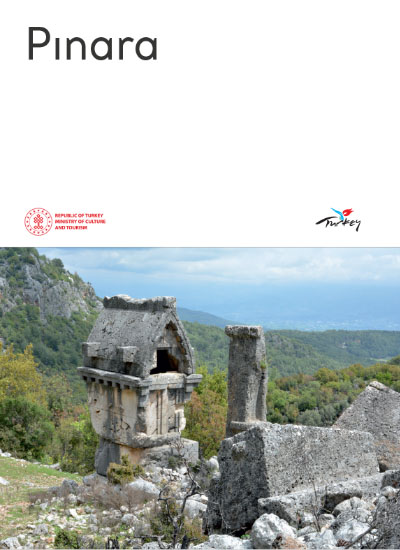According to the Lycian history of Menecrates, quoted by Stephanus of Byzantium, "When the population of Xanthos became very large, a group of old men founded a city on the high hill of Kragos mountain and named it Pınara, which means round." The fact that the upper acropolis, where the remains of the early period of the city are found, is really round in shape gives this mythology a share of reality. The name of the city is read as Pinale in Lycian inscriptions. Strabo, citing Artemidoros, states that Pınara was one of the six cities with three votes in the Assembly of the Lycian Union. The Pınara Ancient City comprises a bath, a theatre, an agora, an odeon, rock tombs, Upper Acropolis and Lower Acropolis. There are numerous rock tombs visible on the steep eastern slope of the upper acropolis. In a relatively short period of time, the upper acropolis became inadequate for habitation. Consequently, the lower acropolis, which is more easily accessible, was opened to settlement. Despite the steep slopes of the lower acropolis, a city wall was constructed to create terraces and for fortification. Upon entering the city through the gate in the south of the city wall, the Odeon, which rests on the slope, and the agora on the flat area in front of it, constitute the focal point of the city. The area around the water spring in the lower part of the lower acropolis is notable for the many tombs carved into the rocks, which were largely destroyed by the earthquakes that the city suffered in ancient times. The majority of the rock tombs here are of the house type, and one of them is notable for the reliefs on the pediment and ante wall. These reliefs depict a city encircled by walls, which has led to the suggestion that the city depicted in the relief should be identified with the prince of Pinara. On the eastern slope of the lower acropolis, outside the city walls, there are remains of a Roman bath, which is similar in plan and location to those found in many cities of the Lycian region. The second building in the city outside the city walls is the theatre, located opposite the acropolis and the baths and backed against the natural slope. The theatre reflects the characteristics of the Hellenistic Period in terms of plan and location.
FETHİYE PINARA ARCHAEOLOGICAL SITE


